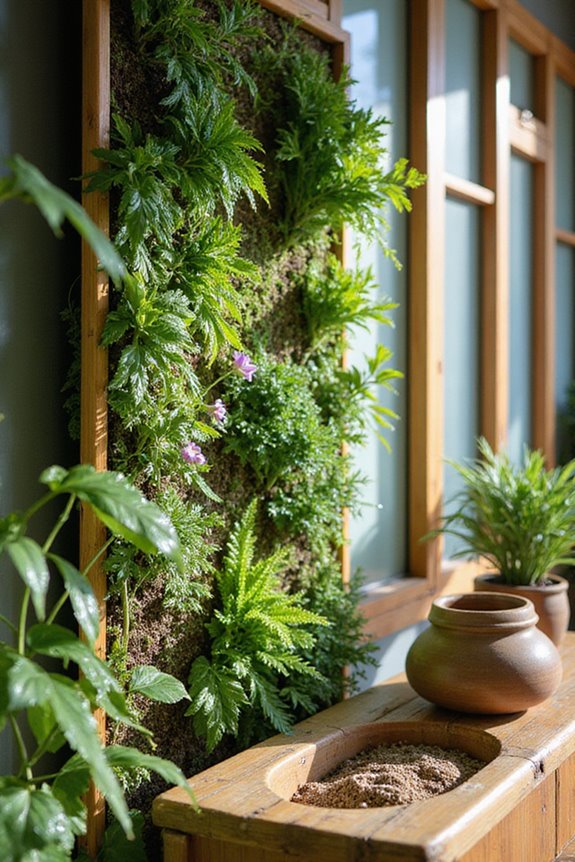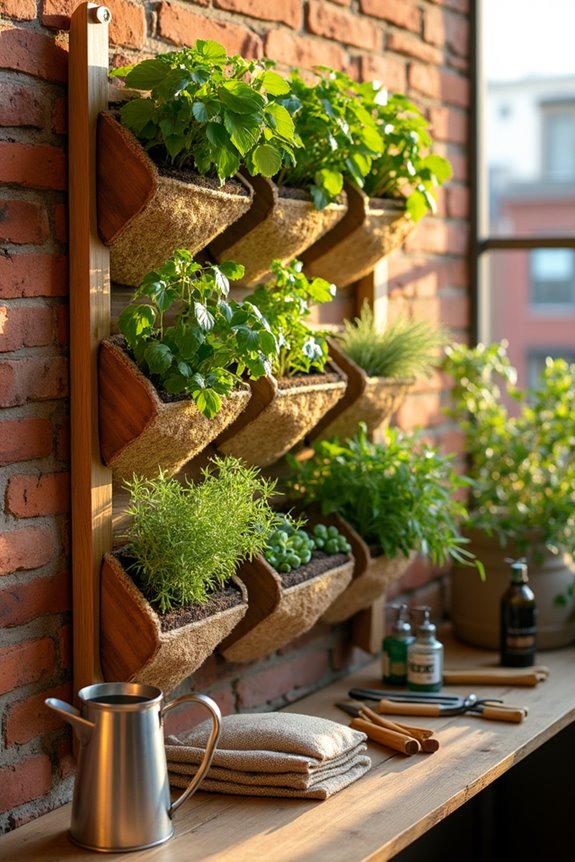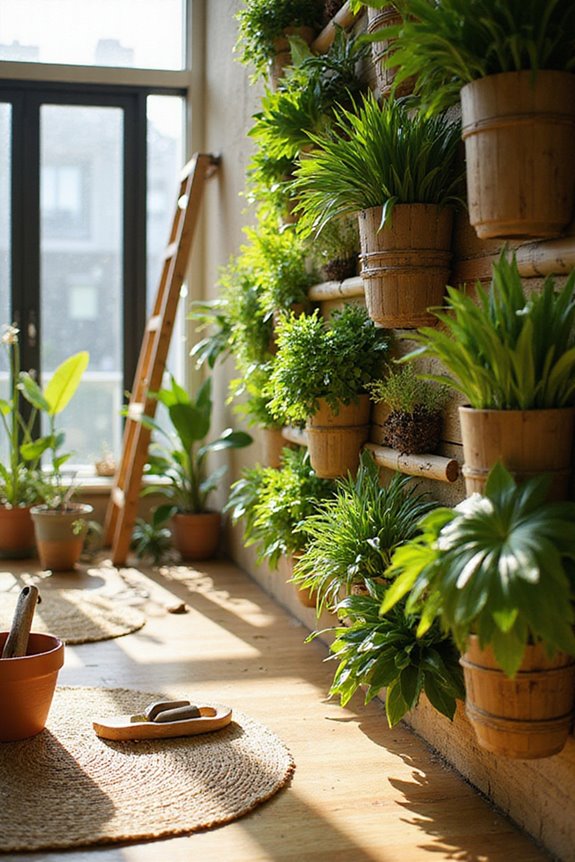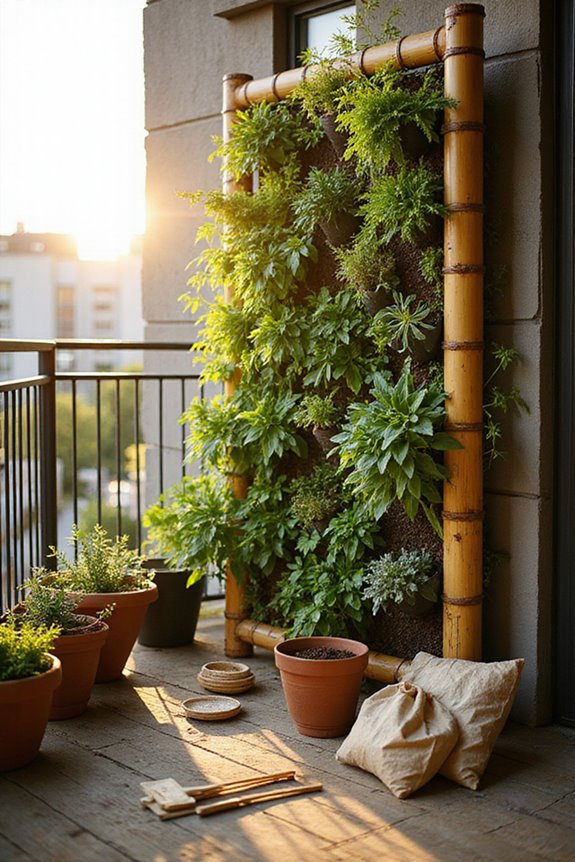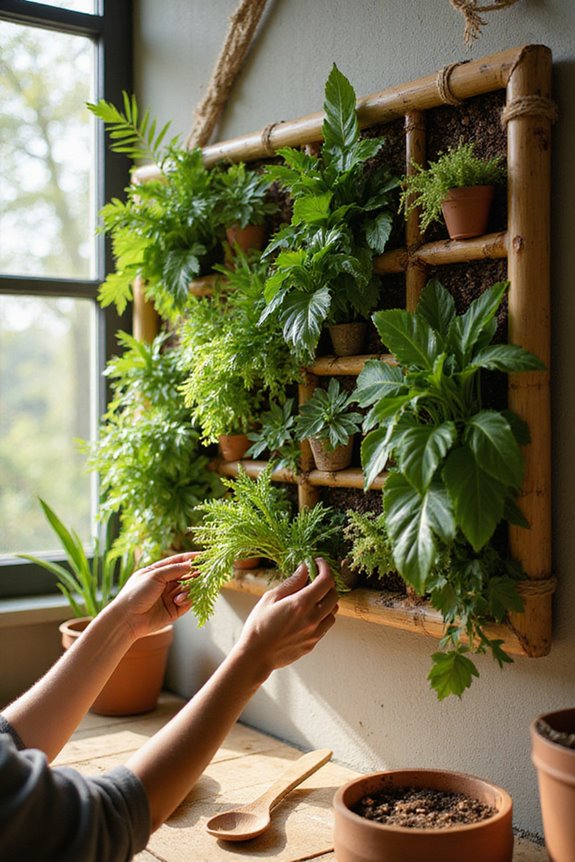Living wall irrigation systems efficiently deliver water and nutrients to vertical gardens. These systems include components like reliable water supply lines, backflow preventers, and micron filters to keep everything clean. We can use various setups such as drip irrigation or hydroponics to suit different plants. Additionally, recirculating systems recycle water, promoting sustainability. Proper maintenance and monitoring help guarantee plant health. If you want further insights, there’s more to explore about their benefits and best practices.
Key Takeaways
- Living wall irrigation systems provide consistent hydration for vertical gardens through various setups, including modular and hydroponic methods.
- They utilize components like water supply lines, backflow preventers, and micron filters to ensure efficient water delivery and quality.
- Recirculating systems recycle excess water, reducing waste and allowing for automated watering based on plant needs.
- Operational control through zoning optimizes irrigation management, allowing tailored care for different plant types or wall segments.
- Regular maintenance and water quality monitoring are essential to prevent clogging and promote plant health in living walls.
Components of Living Wall Irrigation Systems
When we think about living wall irrigation systems, it’s important to understand their key components. First, we need reliable water supply lines that maintain stable pressure between 25 to 85 PSI. This guarantees our pressure regulators can effectively manage the flow to our drip emitters.
Next, we should install backflow preventers to protect our water source from contamination. Valves control water delivery, needing around 8-10 gallons per minute for each irrigation zone.
Additionally, micron filters help prevent debris from clogging our emitters. Using UV-resistant pipes and fittings, such as SCH 80 gray PVC, connects all these components seamlessly.
Recirculating Irrigation Systems

Recirculating irrigation systems offer a smart solution for maintaining living walls, especially in spaces without direct water access. These systems recycle water from a reservoir, pumping it through the wall and returning excess water back for reuse. This design innovation maximizes water conservation, making it ideal for areas without plumbing.
Key components include:
- Water Storage Tank: Often decorative, it blends into the living wall.
- Pump and Tubing: Delivers water evenly to plant pockets.
- Timers: Automate watering based on plant needs.
These systems are scalable, accommodating various wall sizes and environments. With regular maintenance, such as checking for clogs, we can guarantee peak performance and promote healthy plant growth.
Types of Irrigation Setups for Living Walls
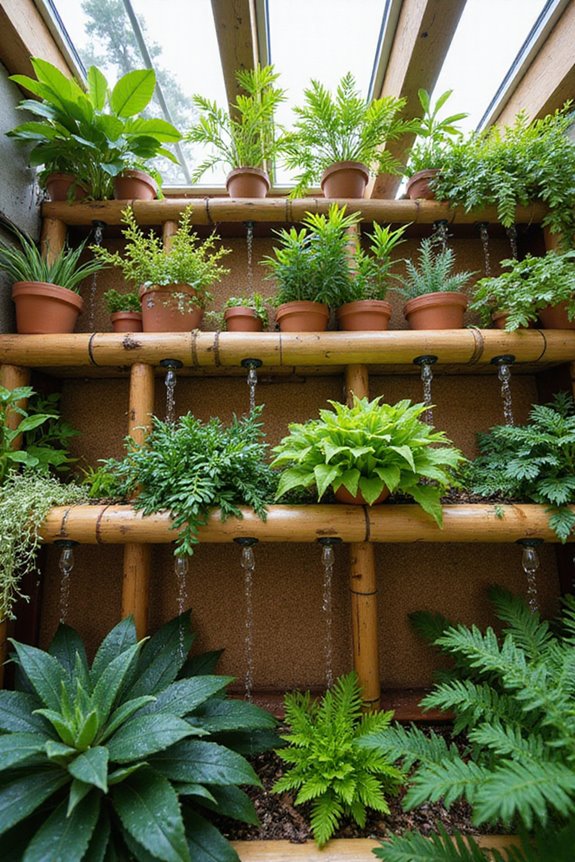
Irrigation setups for living walls come in various types, each catering to different needs and environments. Here are some popular options:
1. Modular Setups
These use pre-planted panels or trays and often feature drip systems. They’re great for indoor spaces like hotel lobbies.
2. Hydroponic Systems
Plants grow in nutrient-rich water solutions, optimizing water usage and supporting larger installations.
3. Soil Substrates
These systems support a wider range of plants but require more maintenance. Drip irrigation helps manage moisture levels.
4. Direct Watering
This connects living walls directly to water lines, providing consistent hydration with effective drainage.
5. Manual Methods
For smaller or temporary walls, hand watering can be practical, though it demands regular maintenance.
Choosing the right setup depends on your specific needs!
Operational Control and Zoning
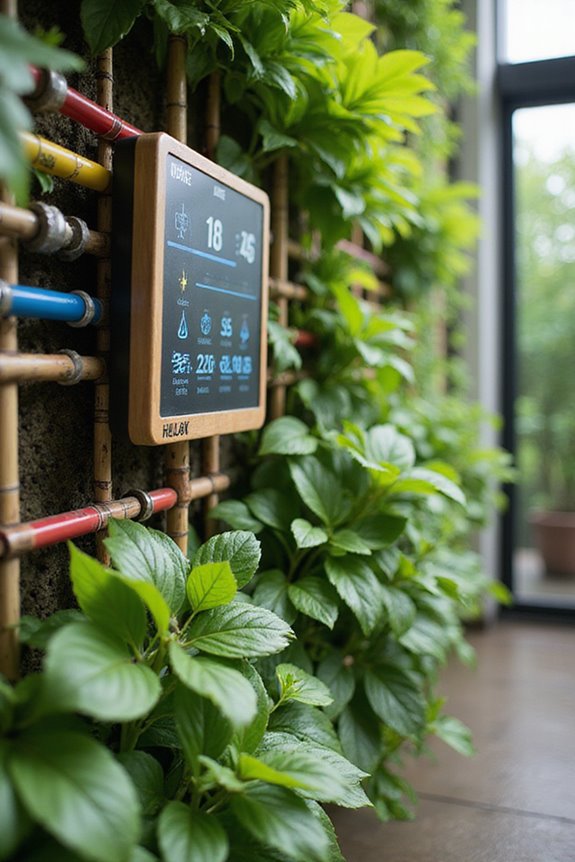
Operational control and zoning play a vital role in managing living wall irrigation systems effectively. By dividing the wall into irrigation zones based on plant types or segments, we can achieve better zone optimization. Each zone is operated through dedicated solenoid valves, allowing for remote monitoring and adjustments. This means we can independently monitor and manage the water needs of specific sections without disrupting the entire system.
Additionally, we can adjust zone boundaries during or after installation for enhanced efficiency. Automated alerts keep us informed of flow rate anomalies, ensuring immediate action can be taken. This targeted approach not only promotes plant health but also simplifies maintenance, making it easier for us to keep our living walls thriving.
Water Quality and Maintenance Considerations
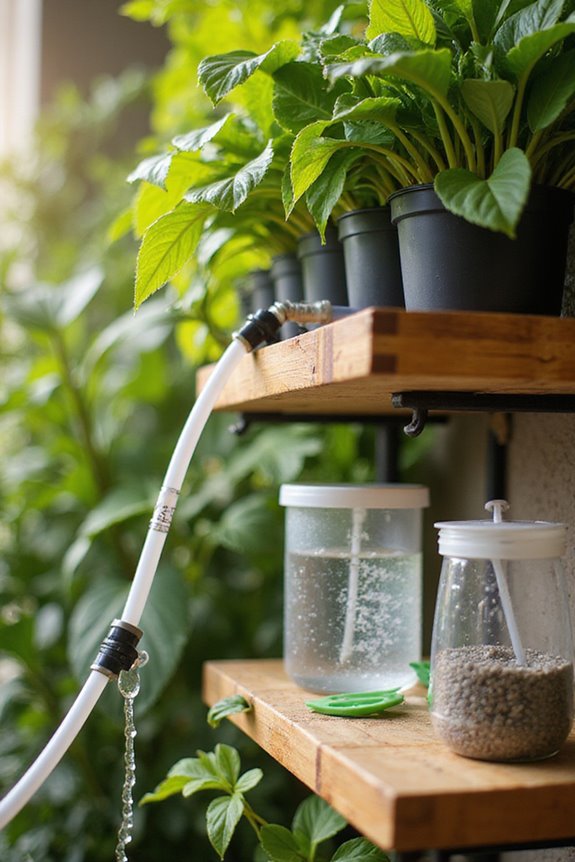
Water quality is essential for the success of living wall systems, especially since it directly impacts plant health and growth. To keep our plants thriving, we need to address potential water quality challenges. Stormwater can introduce impurities like rust and pollutants. That’s why we must implement effective filtration systems. Regular water testing is important, helping us catch any nutrient deficiencies or harmful contaminants before they cause harm.
To maintain ideal conditions, we should also monitor pH levels and nutrient balance. Monthly system checks are critical. This includes cleaning filters, checking for leaks, and guaranteeing even water distribution. Proper maintenance prevents clogging and enhances plant health. By staying proactive, we can make sure our living wall systems flourish beautifully!
Advantages and Suitability of Different Irrigation Types
When choosing the right irrigation type for our living walls, it’s important to take into account the unique needs of our plants and space. Here are some options to evaluate:
- Direct Irrigation Systems: Great for larger walls, they deliver water directly but waste more.
- Recirculating Systems: Ideal for smaller walls, they reuse water, enhancing water efficiency and reducing sustainability impact.
- Drip Irrigation: This method targets roots directly, minimizing evaporation and allowing for nutrient integration.
- Hydroponic Systems: They use nutrient-rich water and promote faster growth, making them highly efficient.
- Non-recirculating Systems: Simpler to manage but less sustainable, they’re more suited for smaller gardens.
Each type has its strengths, so we can choose based on our specific needs and goals.
Importance of Backflow Prevention
Backflow prevention is vital for the safety and quality of our living wall irrigation systems. It helps stop contaminated irrigation water from flowing back into our drinking supply. This is critical when using fertilizers and chemicals, as we don’t want harmful substances affecting our water quality.
- Regulatory Compliance: Many local codes require backflow preventers to protect public health.
- Device Installation: We typically install these devices after faucets or irrigation controllers.
- Routine Backflow Testing: Regular testing guarantees these devices function properly, maintaining safe water flow.
Managing Water Pressure and Flow
Effective management of water pressure and flow is essential for the success of our living wall irrigation systems. By focusing on pressure optimization, we can prevent tubing blowouts and guarantee uniform water distribution to all emitters. High pressure can damage delicate components, so maintaining flow consistency is key for plant health.
To achieve this, we should consider the following:
- Use pressure regulators to maintain safe pressure levels.
- Adjust flow rates based on specific plant needs and environmental conditions.
- Implement automatic timers for consistent watering cycles.
Integration of Fertilization Systems
Integrating fertilization systems into our living wall irrigation setups can considerably enhance plant health and growth. By using fertilizer injectors, we can automate fertigation, delivering a consistent low dose of nutrients each time we water. This method, particularly with organic liquid fertilizer concentrates, guarantees our plants receive the right nutrients at the right time.
We can also consider manual options, like slow-release granular fertilizers, which need to be activated with water.
Here’s a quick look at our options:
- Fertigation: Automatic, precise nutrient delivery.
- Manual Fertilization: Granular or liquid types, applied as needed.
Environmental Benefits of Efficient Irrigation
When we think about the environmental benefits of efficient irrigation, it’s clear that these systems play an essential role in conserving our precious water resources. Here are some key points to reflect on:
- Water Conservation: Efficient methods like drip irrigation minimize waste by delivering water directly to plant roots, preserving freshwater and reducing strain on municipal supplies.
- Energy Efficiency: Low-pressure systems require less energy to operate, cutting down on costs and lowering our carbon footprints.
- Soil Protection: Controlled watering prevents erosion and runoff, maintaining soil health and enhancing water quality.
- Sustainable Landscaping: By supporting native and drought-tolerant species, we can create eco-friendly spaces that benefit local wildlife and ecosystems.
Frequently Asked Questions
How Do Living Wall Irrigation Systems Affect Plant Growth?
It is understood that effective living wall irrigation systems greatly enhance plant health by optimizing moisture retention. When tailored to specific needs, they promote vibrant growth and minimize maintenance, creating lush, inviting spaces we all appreciate together.
Can I Install an Irrigation System Myself?
Imagine transforming our space with lush greenery! We can absolutely tackle a DIY installation together, but we’ll need to stay committed to irrigation maintenance. With planning and teamwork, our living wall will thrive beautifully!
What Plants Are Best Suited for Living Walls?
When considering plant selection for our living walls, we should focus on wall compatibility. Varieties like pothos, ferns, and philodendrons thrive beautifully, creating lush greenery that brings our shared spaces to life together.
How Often Should I Check the Irrigation System?
We recognize the importance of regular irrigation maintenance, don’t we? By checking our system monthly during growing seasons and adjusting as needed, we guarantee our plants thrive, fostering a vibrant community we all cherish together.
Are There Eco-Friendly Options for Irrigation Systems?
Absolutely, we can explore eco-friendly irrigation options together! Using sustainable materials in our systems, along with drip irrigation methods, helps us conserve water while nurturing our green spaces. Let’s make environmentally conscious choices for our living walls!

